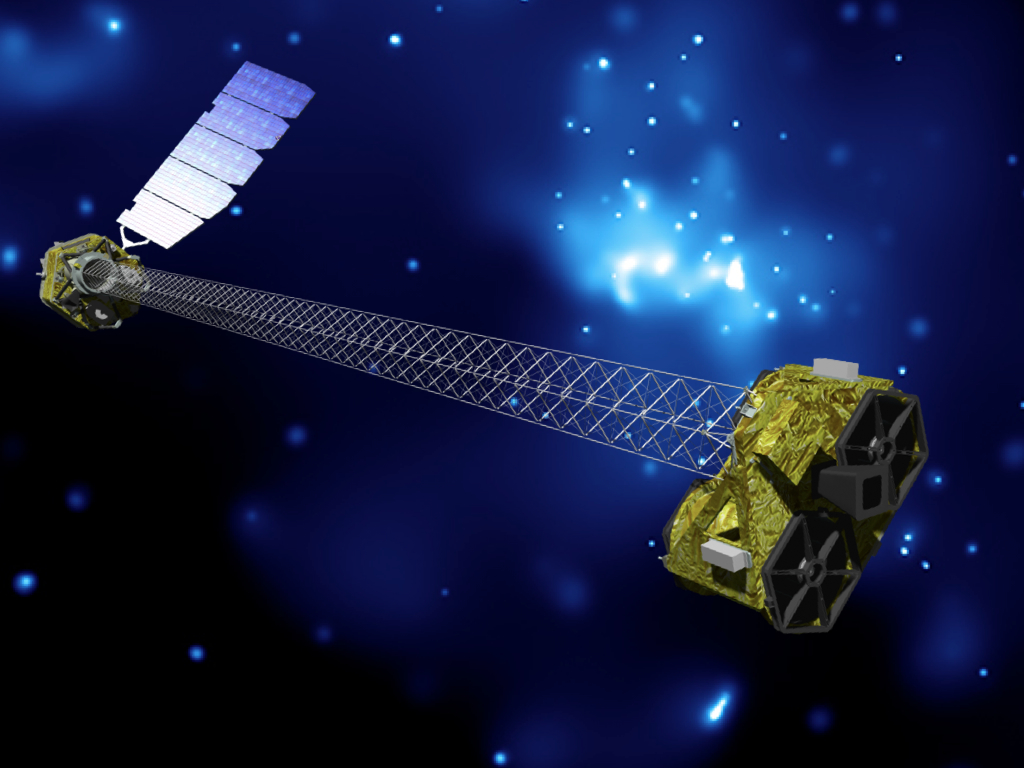New Black Hole Space Telescope Unfolds 33-Foot Mast in Orbit

NASA's newest space telescope — a black hole-hunting observatory — unfolded a giant mast in orbit Thursday (June 21), one of the final steps before it can begin peering deep into the universe.
The $165 million Nuclear Spectroscopic Telescope Array (NuSTAR) is an X-ray observatory designed to study some of the most energetic and mysterious places in the universe through X-ray light. In order to focus these very short-wavelength, high-energy light rays, the telescope must separate its light-gathering optics from a focal point a distance away.
That's where NuSTAR's mast comes in. The 33-foot (10-meter) boom made of stackable cubes formed by carbon fiber rods serves to distance the telescope's two X-ray optics from the focal point where its camera is placed.
"The high energy nature of the mission means we're trying to push beyond the conventional X-ray band, what we call soft or low-energy X-rays," said William Craig, NuSTAR instrument manager at the University of California at Berkeley. "Mirrors can reflect or bend high-energy X-rays, but they can only put in a little glancing angle, so it takes a long distance for it to come to focus. It turns out that 10 meters is the right one to give the focus and energy range we need."
The mast began extending from its storage canister Thursday (June 21) at 1:40 p.m. EDT (1740 GMT). The process took about 28 minutes for the mast motor to crank out the structure. It wrapped up by around 2:10 p.m. EDT ( 1810 GMT), with the mast fully extended and apparently functioning as planned. [Gallery: NASA's Black Hole-Hunting Telescope]
"The mast has deployed! We are on our way to getting the best views yet of high-energy X-rays in our universe!" the telescope's team wrote on Twitter after the event.
The NuSTAR observatory is expected to begin its normal science mission July 31.
Get the Space.com Newsletter
Breaking space news, the latest updates on rocket launches, skywatching events and more!

The NuSTAR mission launched June 8 and has been going smoothly so far. Its planners, who have devoted years to preparing the spacecraft, say it's a heady feeling to have it finally in space.
"Its tremendous, there's no better feeling in the world really," Craig told SPACE.com Wednesday (June 20). "You work through development of the technology, getting it through the NASA process to get it funded, and now it's just going surprisingly well. I think the entire team is excited right now."
Now only one more major step stands between NuSTAR and the start of its operations. Scientists are planning to instruct the telescope to turn on its X-ray detectors Friday (June 22).
Afterward, NuSTAR will point its X-ray eyes at the nearby black hole Cygnus X-1, which is in our own galaxy. These observations should allow mission controllers to test the telescope's focus, and also gather better pictures of Cygnus X-1 than have been available before in this energy range.
Follow Clara Moskowitz on Twitter @ClaraMoskowitz or SPACE.com @Spacedotcom. We're also on Facebook & Google+.
Join our Space Forums to keep talking space on the latest missions, night sky and more! And if you have a news tip, correction or comment, let us know at: community@space.com.

Clara Moskowitz is a science and space writer who joined the Space.com team in 2008 and served as Assistant Managing Editor from 2011 to 2013. Clara has a bachelor's degree in astronomy and physics from Wesleyan University, and a graduate certificate in science writing from the University of California, Santa Cruz. She covers everything from astronomy to human spaceflight and once aced a NASTAR suborbital spaceflight training program for space missions. Clara is currently Associate Editor of Scientific American. To see her latest project is, follow Clara on Twitter.
